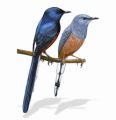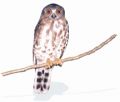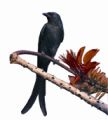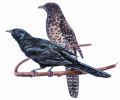Bird
Bird (pakhi) warm-blooded, egg-laying, vertebrate animal of class Aves having its body covered with feathers and forelimbs modified into wings. They have a relatively large brain, keen sight, and acute hearing, but little sense of smell.
Birds appeared more than 150 million years ago during the Jurassic period. They are often considered feathered dinosaurs; this realisation arose as a result of the discovery (in Bavaria, southern Germany in 1861) of the fossil of the oldest known bird, Archaeopteryx lithographica. It had lived during the late Jurassic period, 200 to 145 million years ago. Although Archaeopteryx is related to birds, much of its skeleton recalls that of theropod dinosaurs.
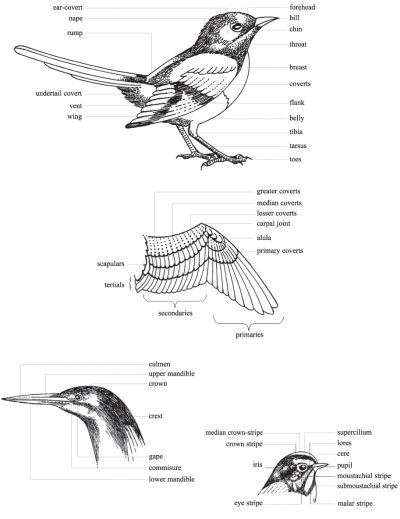
Birds have a common ancestry with reptiles. Paleontologists believe that among the living reptiles, crocodilians may be the closest relatives of birds. Birds possess 2 major anatomical adaptations: feathers, probably evolved from reptilian scales, which provide an insulating coat and give them the ability to maintain a constant body temperature; and considerably modified forelimbs, from the five-fingered form of their probable reptilian ancestors to a wing covered with specially adapted feathers, which give birds the power of flight.
Today the class Aves consists of approximately 9,000 species, grouped into 24 orders. The order Passeriformes (known as passerines or songbirds) contains more than half of the known bird species. The remaining orders are known collectively as non-passerines. Birds are of many different shapes and sizes: Ostrich Struthio camelus, standing about 2.5 m tall; Hummingbird Mellisuga healenae, measuring less than 6 cm from tip of bill to tip of tail, is possibly the smallest bird in the world. Over 1200 bird species occur in the Indian subcontinent. Bangladesh has 628 species (16 orders and 67 families; 276 passerine and 352 non-passerine), of which 388 are resident (16 orders and 60 families; 171 passerine and 217 non-passerine), and 240 are migratory (10 orders and 33 families; 105 passerine and 135 non-passerine). Sarus Crane (Grus antigone) is the largest (standing about 1.75 m tall) bird in the subcontinent, but it is now a rare occurrence in Bangladesh.
-
Black-shouldered Kite, Elanus caeruleus
-
White-throated Kingfisher, Halcyon pileata
-
Indian Pond Heron, Ardeola grayii
-
Magpic-robin: female (left), male (right)
-
Bank Myna, Acridotheres ginginianus
-
White-breasted Waterhen, Amaurornis phoenicurnus
-
White-rumped Shama, Copsychus malabaricus
-
Brown Hawl Owl, Ninox scutulata
-
Baya Weaver, Ploceus philippinus
-
Black Drongo
-
Asain Cuckoo: male (left), female (right)
-
Green Dove
A few flowerpeckers and sunbirds, smaller than the sparrow, are perhaps the smallest. The bird population is shrinking every day. One of every nine species of birds is now threatened with extinction. Today 41 species (out of 388 species of resident birds) are threatened in Bangladesh, of which 19 are critically endangered, 18 endangered and 4 are vulnerable. Of the 388 resident species, the status of 158 could not be evaluated due to paucity of data. The ecological alterations obviously affected the composition of the avifauna. Birds associated with forests of some sort or with a swampy habitat have declined, and their places taken over by other birds. The Pinkheaded Duck (Rhodonessa caryophyllacea), the Nukta or Comb Duck (Sarkidiornis melanotos), the Common Peafowl (Pavo cristatus), and the Burmese Peafowl (P. muticus) which were more or less widely distributed until 70 or 80 years ago, have virtually disappeared from Bangladesh.
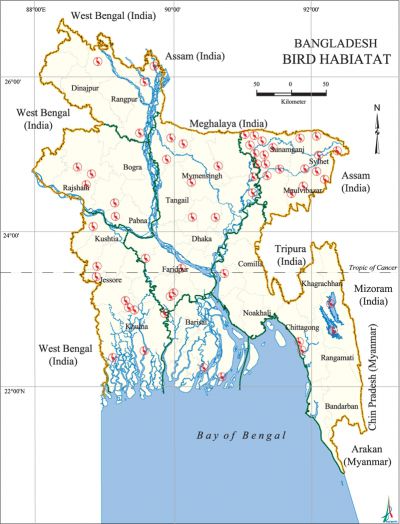
Ornithology in the Indian Subcontinent' The sources of information regarding Indian birds of the pre-Mughal period are not very revealing. Ali (1978) in his Azad Memorial lecture mentions: the English translation of the Sanskrit text of a book Mriqn-Pakshi-Sastra or 'Science of Birds and Animals' by Hamsadeva, said to be a Jain author of the 13th century AD is not very impressive. The other sources of information are the several lexicons of Sanskrit words. Some names are based on calls, others are based on colouration, habits, gait, method of feeding, and so on. Some names are identifiable easily enough, while others are obscure. Perhaps the only person who has attempted to identify birds from such Sanskrit names was the late Raghuvira in his publication Indian Scientific Nomenclature of the birds of India, Burma and Ceylon in 1949. He identifies some 250 Sanskrit words with known species of Indian birds. The Indian Koel and its habit of brood parasitism was well-known to the Vedic seers, and described unambiguously in Sanskrit literature. This appears also to be the earliest record of avian brood-parasitism, since it was described many centuries before Aristotle (384-322 BC) or his immediate colleagues.
The Mughal Emperors, at least from Babur to Shah Jahan, were renowned athletes and lovers of Nature in all its forms. Among them the two most outstanding naturalists were Babur and his great grandson Jahangir. Some of the accounts they have left behind of the habits and behaviour of the birds that came under their personal observations are so apt that they could scarcely be bettered for incisiveness and scientific accuracy today. What is the more creditable about these royal naturalists is that they did not rely on mere hearsay but made a clear distinction in their writings between their personal observations and what had been reported to them by others.
The spread of British power gave enormous scope to officers in the police, civil, forest, and armed services to observe the region’s plentiful bird life. As British power grew, there were increasing numbers of such officers. The result was the pioneering work of Brian Hodgson, TC Jerdon and Edward Blyth. But scientific ornithology, more or less as understood today may, for practical purposes, be said to commence with the publication of the two volumes of Jerdon’s classic Birds of India between 1862 and 1864. In this work the author bestowed an English name on all the birds of India, largely based on British analogies. While many of them are reasonably appropriate, others have gone through numerous attempted improvements by successive authors. It is to be hoped that English nomenclature has at last attained near-stability with the 10 volume Handbook of the Birds of India and Pakistan by Salim Ali and S Dillon Ripley, 1968-73. Cage bird: Parrot
One of the earliest of the 'modern' accounts of Indian birds was actually published in 1713 by Edward Buckley, an East India Company surgeon in Madras, with descriptions and drawings of 22 birds found in and about Fort St George. Several other bird collectors and writers followed during the rest of the century, many of whom have left their mark on Indian ornithology either by describing newly discovered birds, or having such novelties named after them, and in other ways. The first serious attempt at recording the avifauna of a definitive region in India in a scientific journal (Proc. Zool. Soc., London) was a paper in 1831 by a Capt. James Franklin, a geologist, who had undertaken expeditions in the Central and United Provinces to study the rocks in the Vindhyan Hills, and incidentally to collect birds for the Asiatic Society. He collected some 200 birds of 156 species, of which 30 were described as new.
The publication of Birds of India at once gave a marked impetus to bird study in the region, still almost entirely restricted to Europeans. It found new devotees among British officials, planters and professional men, some of whom in turn were soon to become prominent names in Indian ornithology. The period thence, and right up to the publication of the first edition of the Bird volumes of the India office-sponsored Fauna of British India series by Oates and Blanford, was completely dominated by the extraordinary personality, Allan Octavian Hume, who had meanwhile appeared on the scene. Apart from his other great intellectual and humanitarian qualifications Hume's special claim to be remembered in India lies also in the fact that he was one of the original founders of the Indian National Congress.
Indian ornithology received its second definitive boost after Jerdon with the publication between 1889 and 1898 of the 4 volumes on birds by Eugene W Oates and WT Blanford in the Fauna of British India series. Like its predecessor this work brought together, and up to date, all the advances in knowledge resulting from the extensive researches done in field and museum during the intervening 27 years.
Stuart Baker did a little work in Dhaka and elsewhere in Bengal but his main work was in Assam. E Hodge, US Consul in Dhaka from 1957 to 1960, mimeographed five lists of birds observed while out on duty or holiday. In Bangladesh the First comprehensive list was produced by Haroun-er-Rashid in 1967 as the Systematic List of the Birds of East Pakistan, published by the Asiatic Society of Pakistan, and after independence, Birds of Bangladesh by Kazi Zaker Husain appeared in 1979. Mohammed Ali Reza Khan produced a list of birds in his Wildlife of Bangladesh in 1982, and WG Harvey produced another list Birds in Bangladesh in 1990. The first scientific study on birds in Bangladesh started in 1967 at the Department of Zoology, university of dhaka. Now courses on ornithology are offered at the Department of Zoology at Dhaka, Jahangirnagar, and Chittagong universities. In 2000 the IUCN published the Red Book on the avifauna of Bangladesh showing the present status of different species. [Md. Anwarul Islam]
Cage bird Birds that have been traditionally kept in the cages and are successfully bred in captivity, thereby altering many of their natural traits and making them almost domesticated. The best example of these are the psittacines or parrots and some passerines like Canary and Munia. Earliest among these is the Budgerigar Melopsittacus undulatus from Australia.

Originally, John Gould brought specimens of Budgerigar from Australia to UK in 1840. From that time on it has been bred in captivity and through inbreeding and interbreeding with newly acquired specimens it has landed with several dozen varieties of colour forms. The characters of the original species have been altered in the caged birds so much so that many consider it as a 'domesticated' species. However, it is still flourishing well in Australia as a natural species. The Budgerigar is a 17-19 cm small slim parrot whose tail is longer than the body. In nature its colour is bluish black, white and green, with zebra stripes from forehead to upper back, while the wings are mottled. However, the cage birds even have a pure yellow form and many intermediate colour forms.
The other popular cage birds including those found in Bangladesh are Canary Serinus canaria from the Azores, Madeira and Canary Islands in the Atlantic Ocean, west of Algeria; Munia, Lonchura spp., Red Munia or Avadavat, Estrilda amandava (new name Amandava amandava) and Java Sparrow, Padda oryzivora, from Bangladesh and other parts of Asia; Gold Finch, Carduelis carduelis, Green Finch, Carduelis chloris, and Bull Finch, Pyrrhula pyrrhula, from Europe. Bird of prey: Eagle
Game bird Birds that are regularly hunted with guns by hunters and 'sportsmen'; they kill birds either for the fun of knocking down flying birds or just for the heck of it. Generally birds belonging to the order Galliformes, that is the Jungle Fowl, Peacocks and Pheasants comprise the bulk of the game birds. Curlews, godwits, snipes and woodcocks under the family Scolopacidae, and Bengal Florican, a relative of the Bustard, belonging to the family Otididae, and members of several other families are also included as game birds in different parts of the world.

Common game birds in Bangladesh are Red Jungle Fowl (Banmurog/murgi), Gallus gallus; Peacock-Pheasant (Kat Mayur), Polyplectron bicalcaratum; Kalij Pheasant (Mathura or Kalo Mayur), Lophura leucomelanos; Francolins (Titir), 3 spp. of Francolinus; Quails (Botera), 4 spp. of Coturnix and 2 spp. of Turnix; 3 spp. of Partridges belonging to Arboriphila and Bambusicola.
Decades back there were Indian Peafowl (Mayur), Pavo cristatus and Burmese or Green Peafowl (Bormi Mayur), Pavo muticus. Both the species are now extinct in Bangladesh. Red Jungle Fowl is the most common, followed by Mathura, in the forests of Chittagong and Sylhet divisions. Jungle Fowl is common in the Sundarbans. The Bengal Florican Eupodotis bengalensis is feared to be extinct in the country. It was once present in the grasslands of northern Bangladesh and the northeastern areas.
All members of the family Scolopacidae are migratory. Common among these are 2 spp. of Curlews (Gulinda), Numenius; 2 spp. of Godwit (Jurali), Limosa, 13-14 spp. of Sandpipers (Chapakhi Pi-oo), etc., Tringa; 5-6 spp. of Snipes (Chaha or Kadakhucha), Gallinago; Woodcock (Bara or Buno Chaga), Scolopax rusticola; 3-4 spp. of Stints and Dunlins (Baman Chapakhi), Calidris, and Ruff Philomachus pugnax. Of these snipes and woodcock usually occur singly and the others are usually found in flocks of several individuals to several thousands. Most are restricted to the coastal areas, estuaries, charlands, beels, baors, haors, mountainous streams, ponds and lakes. Larger flocks are restricted to the larger water bodies. Woodcock is restricted to the banks of streamlets of the deep forest in the hill districts. [Ali Reza Khan]
Migratory bird Birds that visit the Bangladesh territory periodically, specially in winter. Although migration occurs among other animals like certain insects, fishes, reptiles and mammals, in no other group is it so extensive and prevalent as it is among birds. Birds may be classified according to their migratory status in a given area. Four major groups are recognised: 1. permanent residents; 2. summer residents or summer visitors; 3. winter residents or winter visitors; and 4. transient visitants or passage migrants. Transient visitants include all the species that pass through a locality, usually twice a year: once in the spring, on their way to their breeding grounds, and again in the fall, on their way to their wintering grounds. Migratory behaviour occurs among many different groups of land and water birds. Migration occurs at specific times of the day. Birds that depend on vegetational cover and that are weak fliers are nocturnal migrants; eg, cuckoos, thrushes, wrens, etc. Birds that are fast fliers, that live in the open, or that capture their food on the wing migrate primarily by day; eg, hawks, swallows, shrikes, etc. Some large birds migrate by both day and night; eg, loons, geese, and many waders.

Most birds that migrate to Bangladesh come from the mountainous northern parts of the subcontinent, namely the Himalayas and beyond. Some species come from different parts of Europe and as Far East as Siberia. So all these migratory birds are a part of the massive southward migration of birds from Eurasia to South, Southeast and East Asia. Only a handful of species makes a northward migration to and through Bangladesh. There are certain species that land in Bangladesh and stay for a day or two enroute to destinations further South or Southeast. These are the species in transit. There are still a few species that make a stopover in Bangladesh on passage either during their southern (autumn) or northern (spring) migration and they may spend a longer time than those on transit. There are even species that visit Bangladesh only on passage either during autumn or spring. Migration from north to south or vice versa is referred to as latitudinal or transboundary migration and from an upper elevation to a lower elevation of a mountain is altitudinal migration. Some birds do make east-west migration as well. But such a species possibly does not occur in Bangladesh. Movements within a country or small region are known as local migration.
It is known that there are more than 600 species of breeding birds in Eurasia that are migratory either to South and Southeast Asia or to Africa. Bangladesh receives more than one-third of these birds. There' are only a handful of migrants from Siberia but most visit Bangladesh from the Himalayas and northern Asia. [Ali Reza Khan]
Bird of prey (shikari pakhi) Birds that hunt and kill other animals (especially vertebrates) for food. Such birds, also called raptors, typically have keen senses and sharp, powerful beaks and talons.
Birds of prey are conventionally divided into diurnal birds of prey, such as the eagle, shikra, baza, buzzard, falcon, hawk, harrier, kite, osprey, and vulture; and nocturnal birds of prey, as are the owls. There are about 400 diurnal and nocturnal birds of prey worldwide. Of the 628 bird species that occur in Bangladesh, 68 are birds of prey, of which 37 are resident and 31 are migratory. All these birds belong to the order Ciconiiformes.

Birds of prey are almost exclusively carnivorous, feeding on amphibians, reptiles, birds and mammals, and sometimes fish. They have strong hooked beaks and well-developed musculature for holding and tearing prey. Their toes, three directed forward and one backward, are armed with long, sharp, curving claws (talons). The osprey is widely distributed throughout the world and eats fish, diving at them feet-first and gripping them with its claws and spiked soles. Most hawks and eagles perch or soar until they sight prey on the ground, and then drop from a height to stun and kill it.
Others, such as the peregrine falcon, hobby, and goshawk of the Northern Hemisphere, chase and catch birds on the wing. Old and New World vultures are carrion-eaters. Most have featherless head and neck, and sharp beaks to cope with dead animals. However, they belong to different families, and their similarities are therefore examples of convergent evolution. The small Egyptian vulture eats animal droppings, preferring lion faeces, which are high in undigested protein; it sometimes feeds on eggs, using stones to crack them open. The vultures soar on long, broad wings and have strong feet and relatively straight talons; they must search vast distances to find carrion, then hold it while they tear it with their bills rather than subdue it.
In general, the falcons have a muscular body, long, pointed wings and long toes - all features necessary for swift, agile flight, and the capture of airborne prey. Many of the kites have a relatively slim body and weak fleshy feet, reflecting their generally less predatory habits, their scavenging habit and fondness for easily caught prey. Long-legged harriers and sparrowhawks reach into bushes or grass; sturdy-legged falcons hit prey in the air, often with great force. Some of the large forest eagles have massive legs and talons, and capture monkeys and other large mammals from the trees. Falcons kill their prey with a blow or by biting the prey's neck and severing the spinal cord. Hawks and other members of the family Accipitridae kill by the force of their grip, often compulsively squeezing the victim. All raptors use their feet to hold prey and their bills to dismember it. Raptors that depend on immobile prey are the least dimorphic; the male of these species is about the same size as the female. [Md Anwarul Islam]







